Free Dumps, Free Microsoft Dump
Free AZ-900 Dump
Question #120Topic 1
HOTSPOT –
For each of the following statements, select Yes if the statement is true. Otherwise, select No.
NOTE: Each correct selection is worth one point.
Hot Area:

Correct Answer: 
Box 1: No –
Not all Azure regions support availability zones.
Box 2: No –
Regions that support availability zones support Linux virtual machines.
Box 3: Yes –
Availability Zones is a high-availability offering that protects your applications and data from datacenter failures. Availability Zones are unique physical locations within an Azure region. Each zone is made up of one or more datacenters equipped with independent power, cooling, and networking. To ensure resiliency, there’s a minimum of three separate zones in all enabled regions. The physical separation of Availability Zones within a region protects applications and data from datacenter failures. Zone-redundant services replicate your applications and data across Availability Zones to protect from single-points-of-failure. With Availability
Zones, Azure offers industry best 99.99% VM uptime SLA.
References:
https://docs.microsoft.com/en-gb/azure/availability-zones/az-overview
Question #121Topic 1
HOTSPOT –
For each of the following statements, select Yes if the statement is true. Otherwise, select No.
NOTE: Each correct selection is worth one point.
Hot Area:
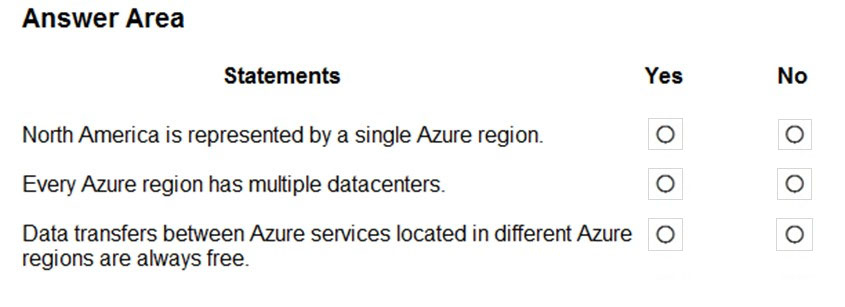
Correct Answer: 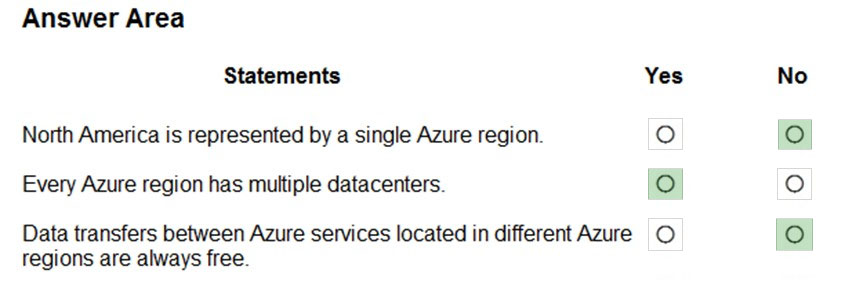
Box 1: No –
North America has several Azure regions, including West US, Central US, South Central US, East Us, and Canada East.
Box 2: Yes –
A region is a set of datacenters deployed within a latency-defined perimeter and connected through a dedicated regional low-latency network.
Box 3: No –
Outbound data transfer is charged at the normal rate and inbound data transfer is free.
References:
https://azure.microsoft.com/en-us/global-infrastructure/regions/ https://azure.microsoft.com/en-us/pricing/details/bandwidth/
Question #122Topic 1
Note: This question is part of a series of questions that present the same scenario. Each question in the series contains a unique solution that might meet the stated goals. Some question sets might have more than one correct solution, while others might not have a correct solution.
After you answer a question in this section, you will NOT be able to return to it. As a result, these questions will not appear in the review screen.
You plan to deploy several Azure virtual machines.
You need to ensure that the services running on the virtual machines are available if a single data center fails.
Solution: You deploy the virtual machines to two or more scale sets.
Does this meet the goal?
- A. Yes
- B. No
Correct Answer: B
This answer does not specify that the scale set will be configured across multiple data centers so this solution does not meet the goal.
Azure virtual machine scale sets let you create and manage a group of load balanced VMs. The number of VM instances can automatically increase or decrease in response to demand or a defined schedule. Scale sets provide high availability to your applications, and allow you to centrally manage, configure, and update many VMs.
Virtual machines in a scale set can be deployed across multiple update domains and fault domains to maximize availability and resilience to outages due to data center outages, and planned or unplanned maintenance events.
Reference:
https://docs.microsoft.com/en-us/azure/virtual-machine-scale-sets/availability
Community vote distribution
B (100%)
Question #123Topic 1
You need to be notified when Microsoft plans to perform maintenance that can affect the resources deployed to an Azure subscription.
What should you use?
- A. Azure Monitor
- B. Azure Service Health
- C. Azure Advisor
- D. Microsoft Trust Center
Correct Answer: B
Azure Service Health provides a personalized view of the health of the Azure services and regions you’re using. This is the best place to look for service impacting communications about outages, planned maintenance activities, and other health advisories because the authenticated Service Health experience knows which services and resources you currently use.
Reference:
https://docs.microsoft.com/en-us/azure/service-health/overview
Community vote distribution
B (100%)
Question #124Topic 1
DRAG DROP –
Match the Azure Services service to the correct description.
Instructions: To answer, drag the appropriate service from the column on the left to its description on the right. Each service may be used once, more than once, or not at all.
NOTE: Each correct selection is worth one point.
Select and Place:

Correct Answer: 
Reference:
https://docs.microsoft.com/en-us/azure-sphere/product-overview/what-is-azure-sphere https://docs.microsoft.com/en-us/azure/iot-central/core/overview-iot-central https://docs.microsoft.com/en-us/azure/iot-hub/about-iot-hub
Question #125Topic 1
HOTSPOT –
For each of the following statements, select Yes if the statement is true. Otherwise, select No.
NOTE: Each correct selection is worth one point.
Hot Area:

Correct Answer: 
Reference:
https://docs.microsoft.com/en-us/azure/virtual-desktop/overview
Question #126Topic 1
HOTSPOT –
To complete the sentence, select the appropriate option in the answer area.
Hot Area:

Correct Answer: 
Reference:
https://blog.abouttmc.com/azure-cloud-total-cost-of-ownership
Question #127Topic 1
HOTSPOT –
For each of the following statements, select Yes if the statement is true. Otherwise, select No.
NOTE: Each correct selection is worth one point.
Hot Area:
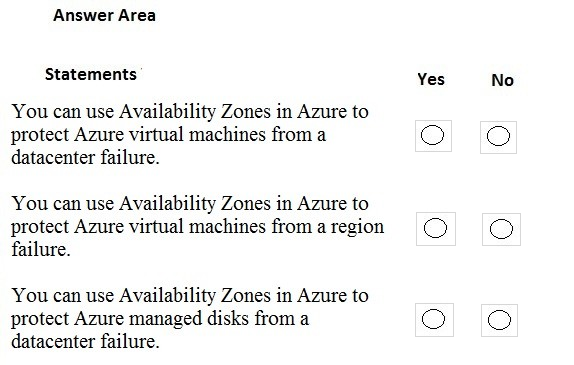
Correct Answer: 
Availability zones expand the level of control you have to maintain the availability of the applications and data on your VMs. Availability Zones are unique physical locations within an Azure region. Each zone is made up of one or more datacenters equipped with independent power, cooling, and networking. To ensure resiliency, there are a minimum of three separate zones in all enabled regions. The physical separation of Availability Zones within a region protects applications and data from datacenter failures.
With Availability Zones, Azure offers industry best 99.99% VM uptime SLA. By architecting your solutions to use replicated VMs in zones, you can protect your applications and data from the loss of a datacenter. If one zone is compromised, then replicated apps and data are instantly available in another zone.
References:
https://docs.microsoft.com/en-us/azure/virtual-machines/windows/manage-availability
Question #128Topic 1
HOTSPOT –
For each of the following statements, select Yes if the statement is true. Otherwise, select No.
NOTE: Each correct selection is worth one point.
Hot Area:
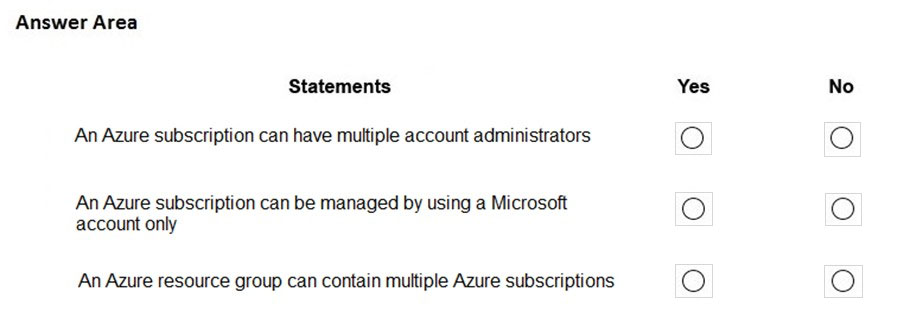
Correct Answer: 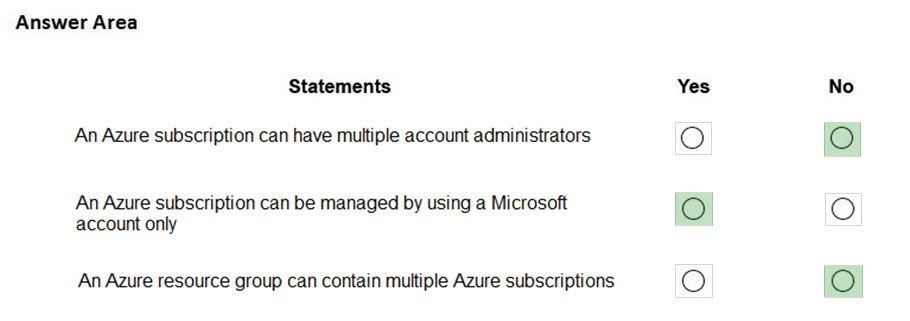
Box 1: No –
A subscription can have multiple administrators, but there can only be one account administrator.
Box 3: No –
A subscription can contain multiple resource groups but a resource group can only belong to one subscription. Resource groups can contain multiple resources.
Reference:
https://k21academy.com/microsoft-azure/az-900/az-900-azure-subscriptions/ https://azure.microsoft.com/en-us/blog/organizing-subscriptions-and-resource-groups-within-the-enterprise/
Question #129Topic 1
HOTSPOT –
Select the answer that correctly completes the sentence.

Correct Answer: 
Question #130Topic 1
HOTSPOT –
For each of the following statements, select Yes if the statement is true. Otherwise, select No.
NOTE: Each correct selection is worth one point.
Hot Area:

Correct Answer: 
Reference:
https://docs.microsoft.com/en-us/azure/active-directory/enterprise-users/groups-dynamic-membership https://petri.com/understanding-hybrid-azure-active-directory-join
Question #131Topic 1
You plan to deploy several Azure virtual machines.
You need to ensure that the services running on the virtual machines remain available if a single data center fails.
What are two possible solutions? Each correct answer presents a complete solution.
- A. Deploy the virtual machines to two or more availability zones.
- B. Deploy the virtual machines to two or more resource groups.
- C. Deploy the virtual machines to a scale set.
- D. Deploy the virtual machines to two or more regions.
Correct Answer: AD
Reference:
https://docs.microsoft.com/en-us/azure/virtual-machine-scale-sets/overview https://docs.microsoft.com/en-us/azure/virtual-machines/windows/regions
Community vote distribution
AD (88%)
13%
Question #132Topic 1
HOTSPOT –
To complete the sentence, select the appropriate option in the answer area.
Hot Area:

Correct Answer: 
Azure automatically routes traffic between subnets in a virtual network. Therefore, all virtual machines in a virtual network can connect to the other virtual machines in the same virtual network. Even if the virtual machines are on separate subnets within the virtual network, they can still communicate with each other.
To ensure that a virtual machine cannot connect to the other virtual machines, the virtual machine must be deployed to a separate virtual network.
Reference:
https://docs.microsoft.com/en-us/azure/virtual-network/virtual-networks-udr-overview
Question #133Topic 1
DRAG DROP –
Match the Azure service to the appropriate description.
To answer, drag the appropriate service from the column on the left to its description on the right. Each service may be used once, more than once, or not at all.
NOTE: Each correct match is worth one point.
Select and Place:

Correct Answer: 
Question #134Topic 1
HOTSPOT –
For each of the following statements, select Yes if the statement is true. Otherwise, select No.
NOTE: Each correct selection is worth one point.
Hot Area:

Correct Answer: 
Box 2: Yes –
Usage scenarios for the hot access tier include:
✑ Data that is in active use or is expected to be read from and written to frequently
✑ Data that is staged for processing and eventual migration to the cool access tier
Box 3: No –
Usage scenarios for the cool access tier include:
✑ Short-term backup and disaster recovery
✑ Older data not used frequently but expected to be available immediately when accessed
Large data sets that need to be stored cost effectively, while more data is being gathered for future processing
![]()
Reference:
https://docs.microsoft.com/en-us/azure/storage/blobs/storage-blob-storage-tiers
Question #135Topic 1
What is the most severe failure from which an Azure Availability Zone can be used to protect access to Azure service?
- A. a physical server failure
- B. an Azure region failure
- C. a storage failure
- D. an Azure data center failure
Correct Answer: D
Availability zones expand the level of control you have to maintain the availability of the applications and data on your VMs. An Availability Zone is a physically separate zone, within an Azure region. There are three Availability Zones per supported Azure region.
Each Availability Zone has a distinct power source, network, and cooling. By architecting your solutions to use replicated VMs in zones, you can protect your apps and data from the loss of a datacenter. If one zone is compromised, then replicated apps and data are instantly available in another zone.
Reference:
https://docs.microsoft.com/en-us/azure/virtual-machines/availability
Community vote distribution
D (100%)
Question #136Topic 1
You need to purchase a third-party virtual security appliance that you will deploy to an Azure subscription.
What should you use?
- A. Azure subscriptions
- B. Azure Security Center
- C. Azure Marketplace
- D. Microsoft Store
Correct Answer: C
Reference:
https://docs.microsoft.com/en-us/azure/cost-management-billing/manage/ea-azure-marketplace
Community vote distribution
C (100%)
Question #137Topic 1
DRAG DROP –
Match the serverless solution to the correct characteristic.
To answer, drag the appropriate serverless solution from the column on the left to its characteristic on the right. Each serverless solution may be used once, more than once, or not at all.
NOTE: Each correct match is worth one point.
Select and Place:
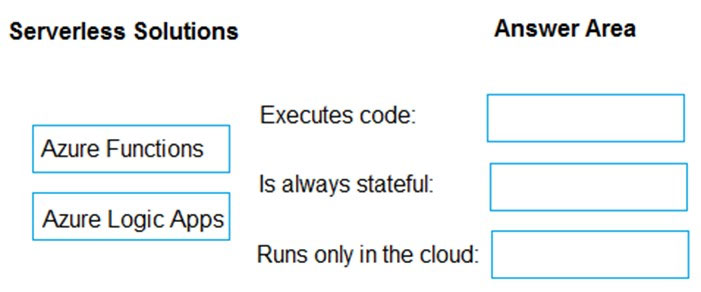
Correct Answer: 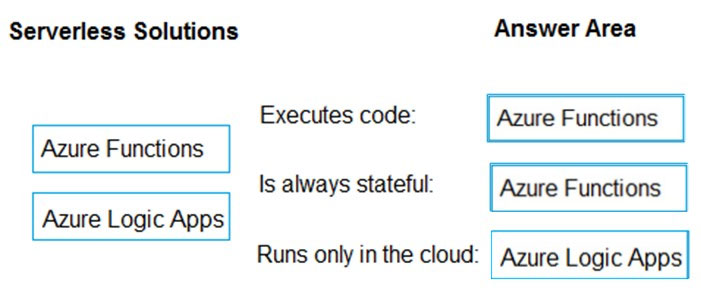
Box 1: Azure Functions –
Azure Functions allows you to implement your system’s logic into readily available blocks of code called “functions”. Different functions can run anytime you need to respond to critical events.
Box 2: Azure Functions –
Azure Logic Apps can have multiple stateful and stateless workflows.
Box 3: Azure Logic Apps –
Azure Logic Apps is a cloud-based platform for creating and running automated workflows that integrate your apps, data, services, and systems.
Reference:
https://docs.microsoft.com/en-us/azure/logic-apps/logic-apps-overview https://docs.microsoft.com/en-us/azure/azure-functions/functions-overview
Question #138Topic 1
DRAG DROP –
Match the Azure governance feature to the correct description.
Instructions: To answer, drag the appropriate feature from the column on the left to its description on the right. Each feature may be used once, more than once, or not at all.
NOTE: Each correct match is worth one point.
Select and Place:

Correct Answer: 
Reference:
https://docs.microsoft.com/en-us/azure/governance/blueprints/overview https://docs.microsoft.com/en-us/azure/governance/policy/overview https://docs.microsoft.com/en-us/azure/azure-resource-manager/management/tag-resources?tabs=json https://docs.microsoft.com/en-us/azure/azure-resource-manager/management/lock-resources?tabs=json
Question #139Topic 1
HOTSPOT –
Select the answer that correctly completes the sentence.
Hot Area:

Correct Answer: 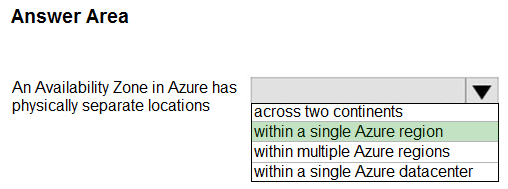
Box: within a single Azure region
Azure availability zones are physically separate locations within each Azure region that are tolerant to local failures.

Reference:
https://docs.microsoft.com/en-us/azure/availability-zones/az-overview

